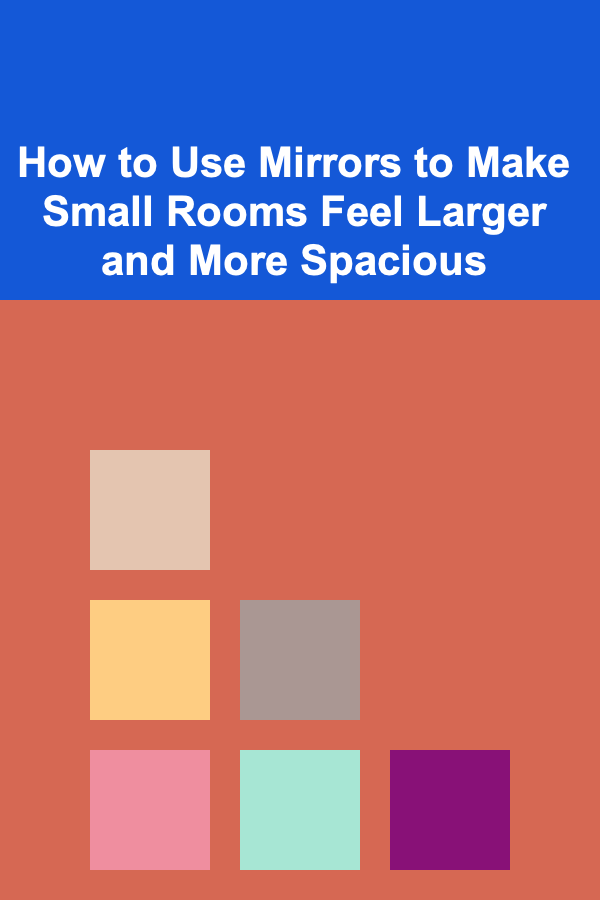
How to Use Mirrors to Make Small Rooms Feel Larger and More Spacious
ebook include PDF & Audio bundle (Micro Guide)
$12.99$9.99
Limited Time Offer! Order within the next:

When living in a small room or apartment, one of the biggest challenges is creating the illusion of more space. The limited square footage can feel constricting, leading to a sense of claustrophobia or discomfort. However, the clever use of mirrors can transform small spaces, making them appear larger and more open. Mirrors not only reflect light but also enhance depth and perspective, contributing to an overall sense of spaciousness.
In this article, we will explore various ways in which mirrors can be strategically placed and utilized to make small rooms feel larger. From choosing the right mirror to positioning them effectively, these tips can help you maximize the potential of your space without the need for extensive renovations or costly solutions.
The Power of Reflection: Understanding How Mirrors Work in Small Spaces
Mirrors work by reflecting light, objects, and spaces in their immediate environment. This reflection creates a sense of depth, which can be particularly beneficial in small rooms that lack natural light or have limited architectural features. When used properly, mirrors not only expand the perception of space but can also make a room feel more open and airy.
1. Maximizing Natural Light
One of the simplest and most effective ways to use mirrors is to reflect natural light. In smaller rooms, a lack of natural light can make the space feel cramped or dark. By placing mirrors near windows, you can reflect the incoming light into other parts of the room, brightening it up and making the space feel more inviting.
Mirror Placement to Reflect Light:
- Opposite Windows: Positioning a large mirror on the wall opposite a window helps capture and bounce the sunlight around the room. This reflection not only brightens up the space but also gives the room a more expansive and open feel.
- Near Light Fixtures: If natural light is scarce, place mirrors near artificial light sources such as lamps or overhead lights. The reflected light will make the room feel lighter, which can trick the eye into perceiving more space.
The key here is to use mirrors to amplify the natural or artificial light that is available, making the room feel brighter and more expansive.
2. Creating Depth and Perspective
Mirrors can add depth to a room, making it feel less flat and more layered. A well-placed mirror can trick the eye into perceiving more space than what is actually there, creating an optical illusion of depth. In a small room, this illusion can help distract from the compact size of the space, adding a sense of dimension and openness.
Strategic Placement for Depth:
- Focal Points: Consider placing a large mirror as the focal point of a small room. The reflective surface can create the illusion of an extended wall, which draws the viewer's eye into the reflection, giving the room a sense of added depth.
- Reflecting Architectural Features: Mirrors can also be used to emphasize certain architectural elements, such as archways, columns, or niches. By reflecting these features, mirrors can enhance the feeling of space while simultaneously highlighting the room's unique characteristics.
The goal is to create a seamless visual flow, where the reflected image draws the eye outward, creating the illusion of depth.
Types of Mirrors to Consider
When it comes to selecting mirrors for small rooms, not all mirrors are created equal. The size, shape, and frame of the mirror can significantly impact the overall effect.
3. Full-Length Mirrors
Full-length mirrors are an excellent choice for small rooms, particularly because of their ability to reflect an entire wall or large sections of the room. A full-length mirror can make a narrow space appear wider by creating the illusion of an extended horizon. Moreover, they are useful for enhancing a sense of airiness in the room.
How to Use Full-Length Mirrors:
- On Narrow Walls: In particularly narrow spaces, a full-length mirror positioned vertically along a wall can give the impression of a wider, more open area.
- Across from Large Furniture: If you have large furniture pieces that might dominate the room, place a full-length mirror across from them. This creates a reflection of the furniture and adds dimension, making the room feel more spacious.
4. Large Mirrors
Large mirrors can be a game-changer in small rooms. While the size of the mirror may seem overwhelming, when placed correctly, a large mirror can expand the visual space dramatically. A large mirror that covers a significant portion of a wall can reflect most of the room, adding a layer of depth that opens up the space.
How to Use Large Mirrors:
- On Feature Walls: If you have a feature wall with minimal decorations, placing a large mirror can enhance the aesthetic while creating an illusion of space. A large mirror works especially well in living rooms, dining rooms, or entryways.
- Over Furniture: Large mirrors placed above furniture, such as sofas or sideboards, can visually "lift" the room, creating the illusion of higher ceilings and a more expansive environment.
5. Mirrors with Decorative Frames
While large and full-length mirrors are effective in expanding space, mirrors with decorative frames can also serve as a focal point that enhances the room's design. A decorative frame draws attention to the mirror, providing an elegant touch that still contributes to the illusion of a larger space.
How to Use Decorative Framed Mirrors:
- Gilded or Modern Frames: For a more classical look, a gilded or ornate frame can add a sense of grandeur, making the room appear more opulent. On the other hand, minimalist frames in modern settings help maintain a sleek and uncluttered look.
- Multiple Small Mirrors: Instead of one large mirror, you can create an array of smaller mirrors with decorative frames. Arranging them thoughtfully on one wall can add dimension while offering a touch of style.
Decorative frames should not overpower the room but rather complement the design. Choose frames that blend with the overall aesthetic while enhancing the visual appeal.
6. Mirrors with Unique Shapes
To add intrigue and personality to a room, consider mirrors with unconventional or unique shapes. Oval, round, or asymmetrical mirrors can introduce a dynamic element that draws attention and adds visual interest without overwhelming the space.
How to Use Unique-Shaped Mirrors:
- Breaking Up Square Lines: If your room is filled with angular furniture or architectural lines, a mirror with a round or oval shape can soften the hard edges and make the space feel more fluid and open.
- Grouped Mirror Display: Grouping several smaller mirrors with unique shapes on a single wall can create a playful yet elegant effect. This adds depth while allowing for creative expression.
Tips for Mirror Placement in Small Rooms
The key to using mirrors effectively in small rooms lies in how and where you place them. Below are some actionable tips for strategically positioning mirrors to maximize their effect.
7. Mirrors Near Doorways
One of the simplest and most effective ways to use mirrors in small rooms is by placing them near doorways or entrances. Mirrors positioned near these areas create a sense of openness and flow, making the room feel more accessible and larger.
How to Use Mirrors Near Doorways:
- Reflecting the Entry: A mirror placed near the door can reflect the surrounding space, creating an immediate sense of openness as soon as you enter. This is especially effective for small entryways or hallways.
- Optical Illusions of Width: If the room is long and narrow, placing a mirror near the entry can help expand the room's perception of width, giving the impression that the space extends further.
8. Mirrors to Reflect the Ceiling
In rooms with low ceilings, mirrors placed strategically can create the illusion of height. By reflecting the ceiling, mirrors help draw the eye upward, making the room appear taller than it actually is.
How to Use Mirrors for Height:
- Ceiling-to-Floor Mirrors: For a dramatic effect, use tall, floor-to-ceiling mirrors that reflect the ceiling. This increases the perception of height, making the room feel airier and less confined.
- Mirrors Above Eye Level: Placing mirrors high on the wall above eye level allows for the reflection of the ceiling without overwhelming the room.
9. Create Reflection of Light Colors
Mirrors reflect not only light but also the colors within a room. If you're working with a small space, pairing mirrors with light-colored walls or light-colored furniture can enhance the feeling of spaciousness. The reflection of soft, neutral colors can increase the sense of lightness and airiness.
How to Use Mirrors with Light Colors:
- Complement Light Paint Colors: If your room is painted in light hues such as white, soft pastels, or light grays, mirrors can reflect these colors, making the room feel brighter and more expansive.
- Light-Colored Furniture: Mirrors positioned near light-colored furniture can reflect the soft tones of the furnishings, contributing to an overall sense of openness and ease.
10. Be Mindful of Mirror Placement in Busy Rooms
While mirrors can work wonders in creating space, it's important to be mindful of where they're placed. In busy rooms with a lot of visual clutter, mirrors can exacerbate the chaos, making the room feel disorienting rather than spacious.
How to Avoid Overwhelming the Space:
- Limit Mirror Use in Cluttered Areas: If you're dealing with a room already filled with intricate patterns or lots of furniture, consider limiting the number of mirrors in that space. Instead, focus on using one or two larger mirrors that don't compete with the existing décor.
- Use Mirrors to Reflect Order: Mirrors work best when they reflect areas of the room that are uncluttered or clean. By carefully considering the areas they reflect, you can ensure that the overall effect contributes to a sense of calm and space rather than creating distractions.
Conclusion
Mirrors are powerful tools in interior design, especially when it comes to enhancing small rooms. By reflecting light, creating depth, and strategically placing mirrors throughout the room, you can significantly expand the perception of space. Whether using large mirrors, full-length mirrors, or mirrors with decorative frames, the key is to position them thoughtfully and consider their effect on the room's atmosphere.
With the right mirror placement and design choices, you can transform even the smallest of rooms into spaces that feel open, airy, and visually expansive. So, start experimenting with mirrors in your home, and watch as your small space begins to feel much larger and more welcoming.
Reading More From Our Other Websites
- [Personal Care Tips 101] How to Lose Weight After 40: A Comprehensive Guide
- [Rock Climbing Tip 101] Seasonal Strategies: Climbing the Best Outdoor Routes in Spring, Summer, Fall, and Winter
- [Home Pet Care 101] How to Groom a Cat: A Gentle Approach to Keeping Your Feline Looking Great
- [Organization Tip 101] How to Create a Calendar for Lease Renewal Dates
- [Organization Tip 101] How to Organize Your Pantry for Batch Cooking
- [Home Rental Property 101] How to Handle Tenant Requests for Repairs and Maintenance
- [Organization Tip 101] How to Encourage Independence with Smart Home Devices
- [Home Staging 101] How to Use Color to Create a Warm and Inviting Home Staging Look
- [Organization Tip 101] How to Maximize Small Spaces for Pet Organization
- [Beachcombing Tip 101] Tools and Techniques: How to Spot Amber on Beaches and Forest Trails

How to Build a Retirement Planning Checklist for Maximizing Savings
Read More
How to Use Coupons and Discounts to Save Money
Read More
How To Apply Eastern Philosophy to Western Life
Read More
10 Tips for Lighting Your Home Like a Pro
Read More
How to Knit a Project Planner That Actually Works
Read More10 Common Disability Insurance Expense Tracking Mistakes (and How to Avoid Them)
Read MoreOther Products

How to Build a Retirement Planning Checklist for Maximizing Savings
Read More
How to Use Coupons and Discounts to Save Money
Read More
How To Apply Eastern Philosophy to Western Life
Read More
10 Tips for Lighting Your Home Like a Pro
Read More